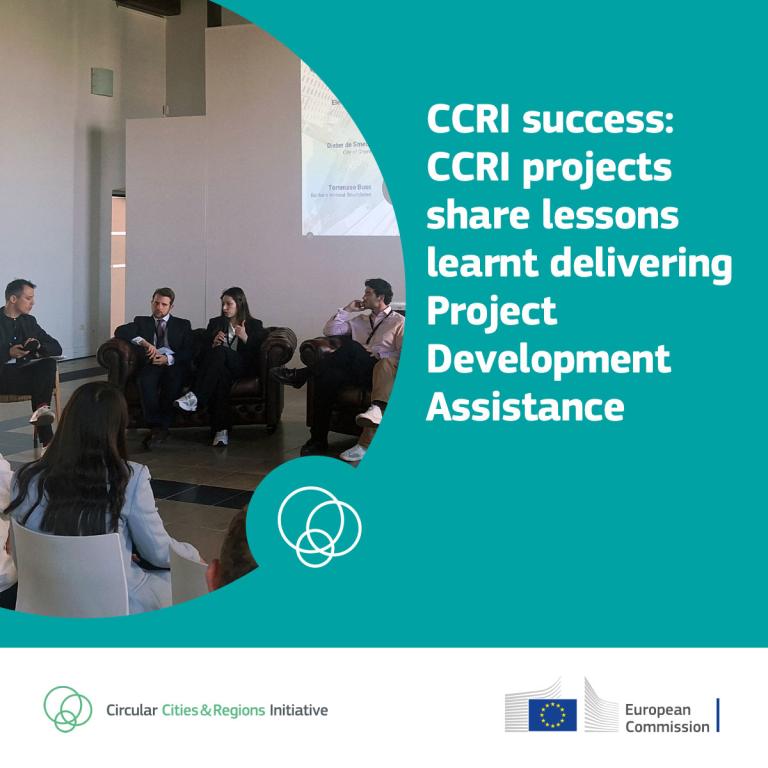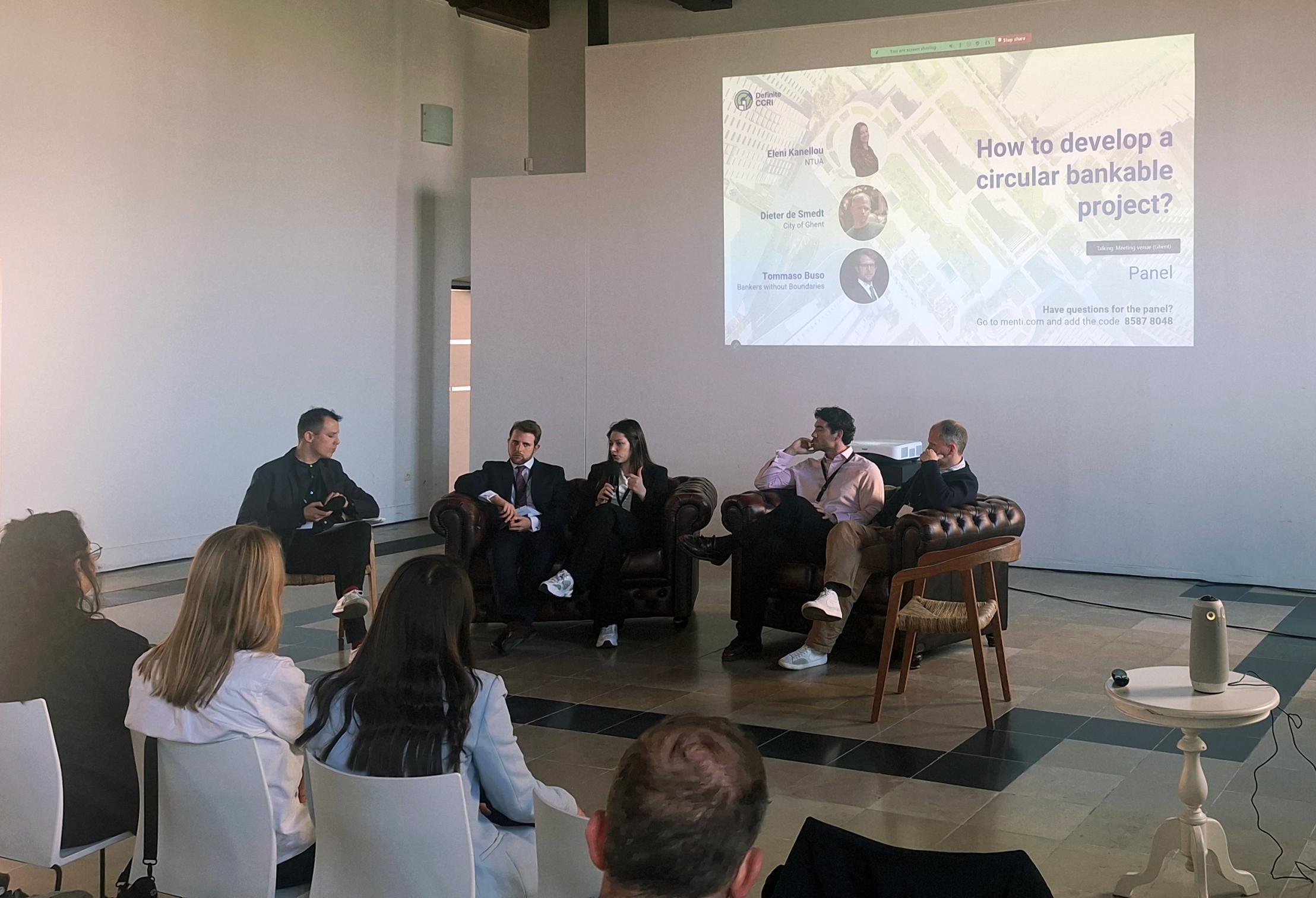CCRI success: Learn how CCRI Project Development Assistance improves circular project maturity and expect EUR 224.4 million in investment
Published on 07.05.2025
The CCRI’s recent Project Development Assistance (PDA) workshop on 24 April brought together CCRI Projects to discuss how to translate local innovation into investment-ready solutions through PDA. CCRI PDA Projects like HOOP, DEFINITE-CCRI, CircularInvest, InvestCEC and RESOURCE attended the workshop to share their investment successes and lessons learnt from giving PDA, building on insights shared at previous events.

More information
The Circular Cities and Regions Initiative (CCRI) has advanced Europe’s circular transition through its Project Development Assistance (PDA) projects, which support circular stakeholders in increasing the maturity and investment readiness of their circular solutions.
This article highlights the value CCRI PDA Projects have brought to the circular economy and lists the lessons learnt they shared at the CCRI PDA workshop, the Definite-CCRI final event, and the DECISO Annual Conference 2024.
What is Project Development Assistance?
PDA helps project promoters to develop their circular economy proposals and put circular strategies into action by bringing together technical, economic and legal expertise and removing obstacles to funding and project initiation.
A PDA project provides advisory services to mobilise investment for circular investment projects. Each of the CCRI PDA Projects have designed methodologies and models to replicate PDA services across Europe.
What challenges do PDA projects face?
PDA projects help to promote projects’ circular solutions and products attractive to investors. They assess and improve the feasibility and bankability of circular projects by tackling (or mitigating) their risks, making the project more mature. They also promote the economic value and environmental benefits of circular solutions or products.
However, delivering PDA is a long and complex process, and PDA projects need time to negotiate with investors. Many projects echoed this during the April PDA workshop, sharing that PDA projects often do not run for long enough to complete discussions with investors or secure investment.
How do CCRI Projects deliver PDA?
HOOP supported urban bio-economy projects by providing tailored PDA to overcome investment barriers. It supported 15 projects focused on valorising municipal solid waste and wastewater sludge into high-value products, achieving a 15x leverage factor, which represents over EUR 124.4 million investment induced into circular projects.
Similarly, DEFINITE-CCRI provides technical, financial and circular economy expertise through its “deal engine” circularity tool, collaborating with investors and finance partners to deliver PDA. It has supported four investment projects to increase their investment readiness and expects to bring investment worth up to EUR 1.4 million.
Capital expenditures and investments are often related to recycling. However, projects that enable the re-use or reduction of secondary raw materials (like those that DEFINITE-CCRI supports with PDA) have large societal benefits without strong investment needs.
InvestCEC focuses on developing a replicable model for the implementation of circular economy projects in Europe, considering all relevant stakeholders, and supports investment projects in Klagenfurt, Austria with a 10x leverage factor, expecting to achieve EUR 20 million investment.
RESOURCE sped up the private funding of circularity-related projects in Aragon, Spain, by bringing together partners from across the entire value chain. It has supported nine pilot projects with an expected investment of EUR 20 million.
In all, CCRI PDA Projects HOOP, DEFINITE-CCRI, CircularInvest, InvestCEC, RESOURCE, BioBoost and DECISO are supporting ca. 50 circular investment projects and aim at a total expected investment of over EUR 220 million.
While some projects are still in early stages and have not yet matured to the investment phase, the substantial progress made demonstrates the growing feasibility and readiness of circular initiatives across Europe.
What lessons have CCRI PDA Projects learnt?
At the recent CCRI PDA April workshop and in previous interactions with the CCRI Office, CCRI PDA Projects shared their lessons learnt helping circular projects secure investment:
- Integration of the investor perspectives early. PDA advisory support showed that it is crucial to include/consider the financial perspective right from the beginning of the interaction with project promoters
- Offer bilateral support tailored to individual project needs. DEFINITE-CCRI found that differentiating between types of projects early on will help to better align expectations, approaches and resource allocation.
- Training and capacity-building on how to pitch to investors are essential when working with early-stage projects. RESOURCE recommended defining the aim and ambition of projects early, crucial for attracting funding from investors.
- Map stakeholders to demonstrate investment readiness. Benchmarking helps to meet venture capitalists’ expectations and innovation workshops are useful find the right investors.
- Share data and cooperate with public entities to improve data availability on material and energy flows. Many investors expect financial returns and want broader social and environmental impacts, adding complexity.
- Fund demonstration projects facing regulatory and structural obstacles that prevent scaling. Demonstration projects prove feasibility but are frequently underfunded due to high costs and investors' reluctance to risk capital without solid business models.
- Being a part of the CCRI helps the circular economy ecosystem. There is potential for synergies in public-private sector collaboration. Support frameworks like the CCRI can help align messaging and goals across green, digital and social domains. The CCRI facilitates investor engagement and ecosystem support for circular initiatives.
- Work with committed circular economy promoters. To test methodologies, act as demonstrator and ensure cooperation and impact, it is important to work with committed promoters, helping start-ups gain data to evidence circular solutions’ replicability and minimise risk for investors.
- Use CCRI PDA project’s existing tools and methodologies to speed up project selection. Some CCRI PDA projects have spent years identifying the PDA needs of investment projects. CCRI Projects developed tools that help identify weak points in the projects, such as those made by HOOP, DEFINITE-CCRI and InvestCEC.
- Select well-developed initiatives that plan to invest. Carefully select well-developed initiatives that are clear on the type and size of investments to support. Circular Invest also suggested that PDA calls should avoid setting strict investment targets for all projects, which is better suited to more mature ventures.
- Check projects do not go against regulations. In HOOP’s experience with biowaste, innovative value chains are often limited by regulatory obstacles. Similarly, InvestCEC and RESOURCE advised that circular projects must be aware of the political and policy environments of the target regions or pilot cities.
- Include indicators to constantly monitor the quality and impact of the PDA. Following a Grant Agreement does not necessarily ensure impact. Therefore, do not wait until the end of the project to monitor the quality and impact of the assistance.
- Map stakeholder engagement. For successful project development and impact, stakeholder engagement mapping is needed alongside technical PDA.
- The projects must be technically and regulatory feasible and flexible. A project must be feasible to be bankable. Therefore, be flexible enough to detect other opportunities in case the project is not feasible or does not find investment.





